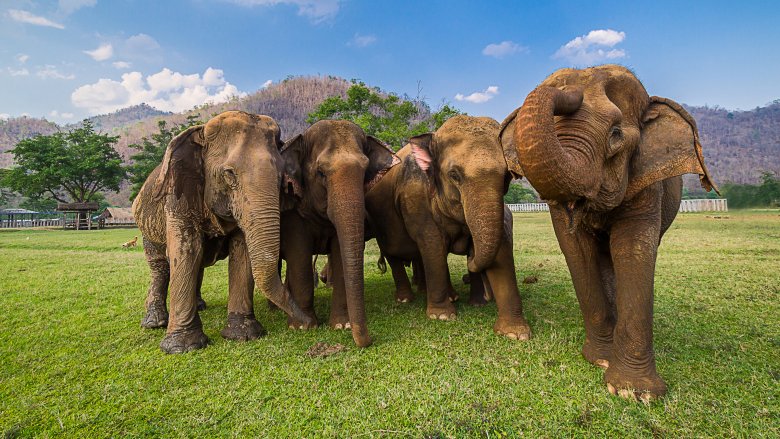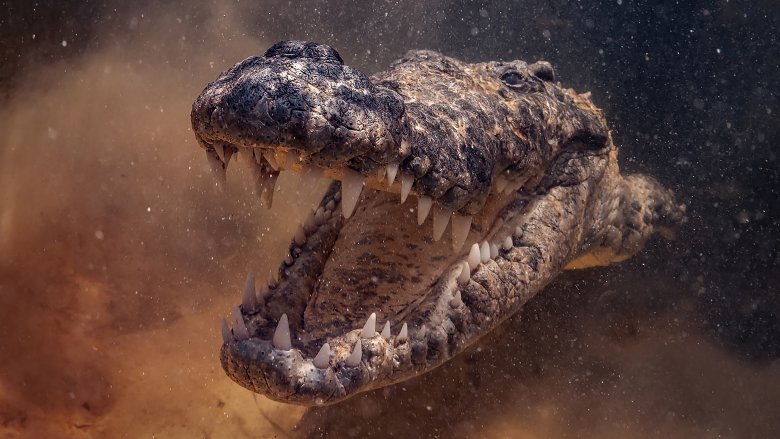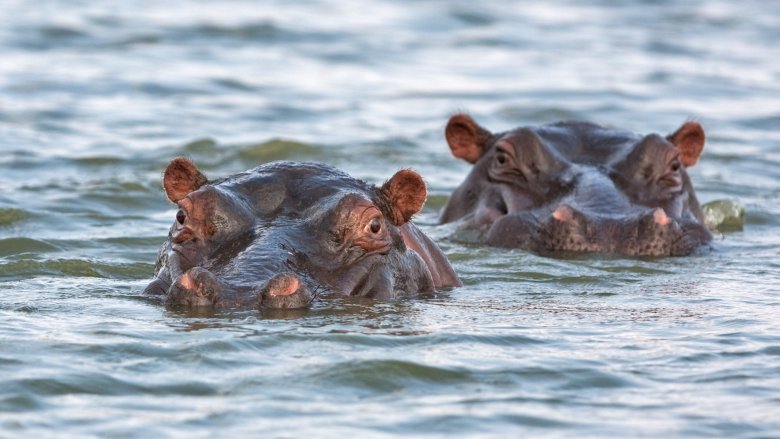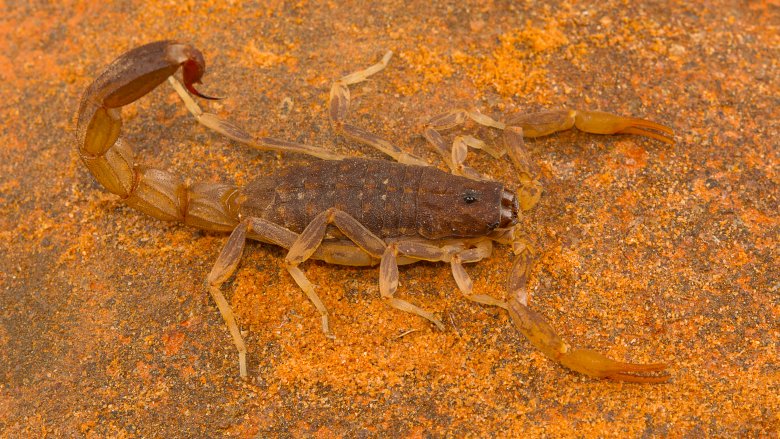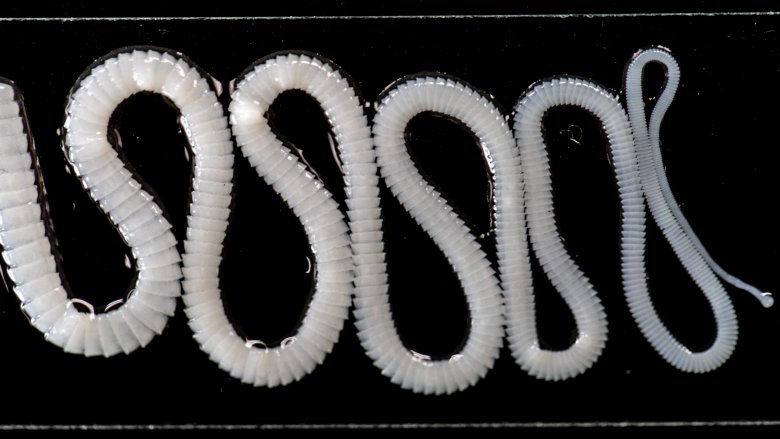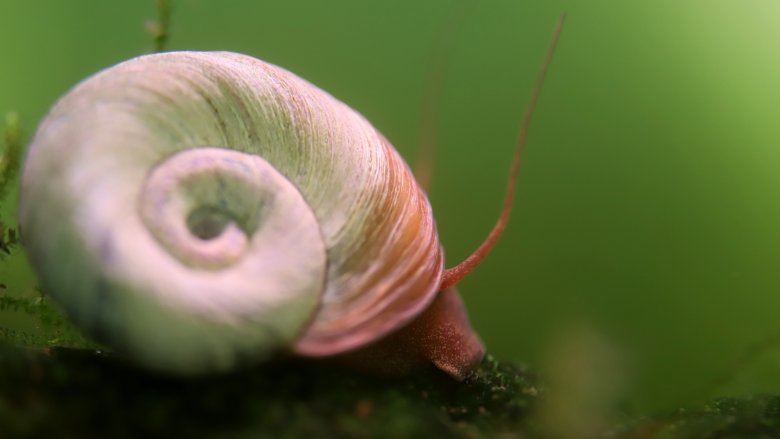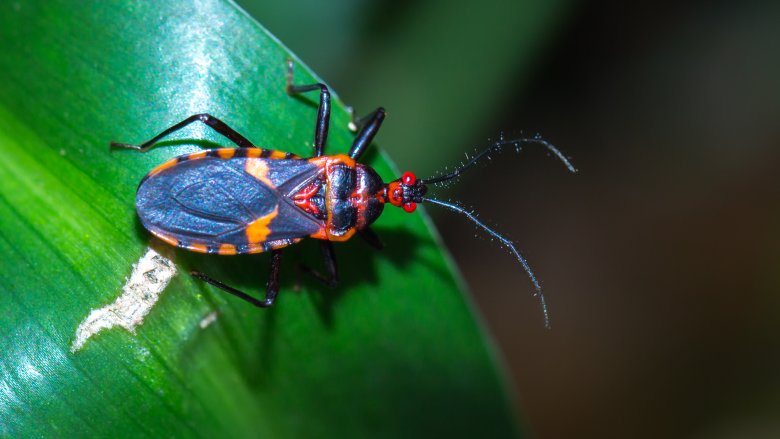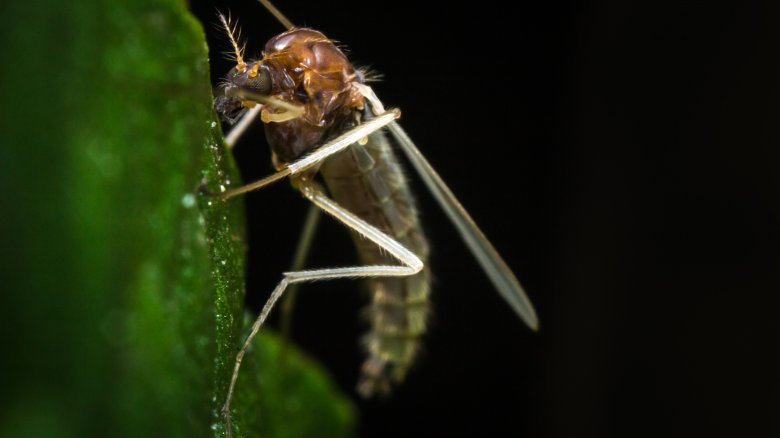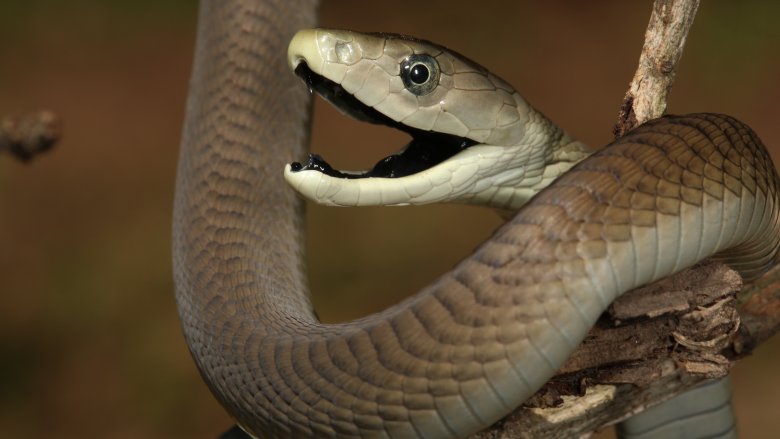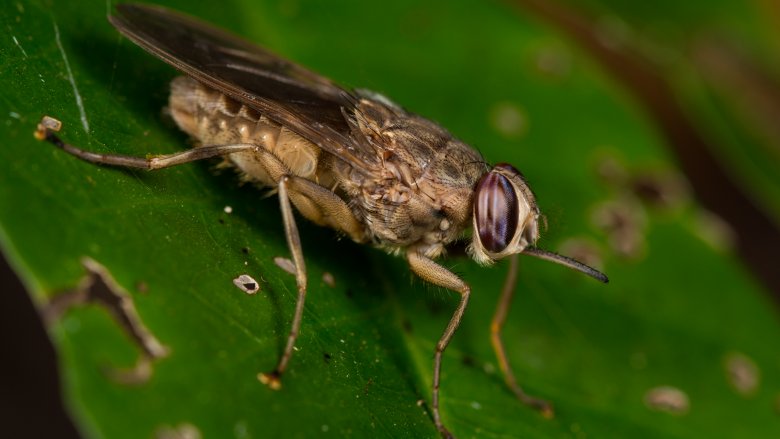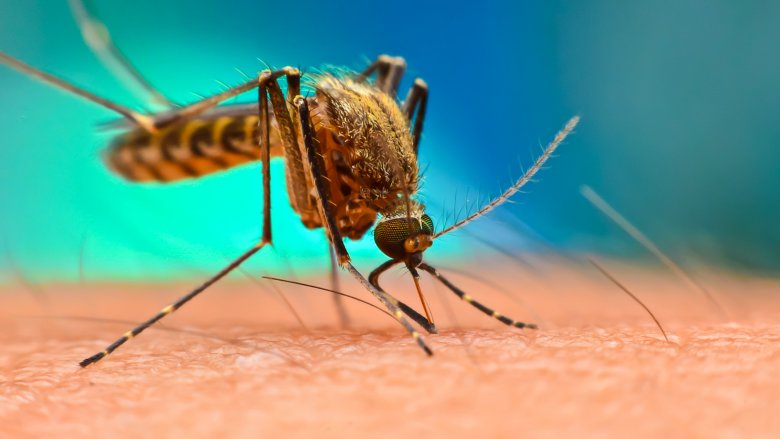What Is The Most Dangerous Animal In The World?
Sharks, piranhas, bears, and box jellyfish — these are some of the most terrifying animals in the world, the ones we worry about when we're swimming in the ocean or camping or getting captured by supervillains who like to devise ridiculously elaborate ways to kill people. But statistically, these are not the most dangerous animals in the world. In fact, they don't even land in the top ten.
Sure, an individual encounter with one or more of these animals might be a pretty dangerous moment, but as far as actual human deaths, well, they just don't kill a lot of people. Sharks take down an average of six swimmers, surfers, and divers every year. Bears only kill an average of three people per year (though they are also responsible for a ton of property damage). Piranhas occasionally kill people ... or they might just eat them after they're already dead. The jury is still out. Box jellyfish are a bit more prolific, claiming between 20 and 40 lives annually in the Philippines alone. But that still doesn't come close to the animals that pose a real threat to human beings. From killer pachyderms to incredibly destructive insects, here are the most dangerous animals in the world.
Believe it or not, elephants are incredibly vicious
Elephants are universally beloved, except by the people they're always killing. Because wherever elephants coexist with people, there is conflict.
According to National Geographic, elephants kill around 500 people every year, and they're becoming more and more aggressive as human beings encroach on their lands. And it's a difficult problem, because the rising human population in places like Nambia means that poor farmers are having to take over new fields on lands occupied by hungry elephants. And when the elephants destroy a farmer's field, the farmer is likely to fight back with guns and poison.
Elephants are intelligent animals, and some biologists think they may actually be responding to the killings of herd members with something like an elephant form of post-traumatic stress disorder. Adults might be driven to become more aggressive as a response to the breakdown of their herd structure, and younger elephants may be learning that aggressive behavior. In fact one researcher said that elephants in a region of Kenya are aggressive to the locals but not to tourists, because they recognize the difference between the humans who regularly hunt them and those who don't.
Crocodiles actually target human beings
When Steve Irwin handled a crocodile with his infant son under one arm, the world was shocked and horrified and for good reason. Crocodiles aren't like trained poodles. They're dangerous and aggressive and really don't seem to have any personal ethics when it comes to devouring human beings.
We like to imagine that sharks are people-hungry killers, but most shark attacks are mistakes. A shark is swimming along, and it sees your silhouette and goes, "Yum, a seal." Then when it realizes its mistake, it tends to swim away. Sure, it leaves you to bleed out in the wide open blue, but at least it didn't mean to kill you.
Crocodiles, on the other hand, don't really care what they're eating, as long as they're eating. According to Business Insider, crocodiles kill around 1,000 people every year, and because they're extremely territorial, they don't just kill for food. They kill because they're ticked off that you're looking at them. And they can move between land and water, which means they can run up on shore, grab you, and then pull you down under the water where you'll drown ... if the blood loss doesn't get you first. So yeah, just stay away from places where crocodiles lurk, and if you must go there, don't bring your infant child with you. Though we do still love you, Steve Irwin.
Hippopotamuses spray poop like a lawn sprinkler ... and they kill people
Yes that's right, we said "hippopotamuses" because that is in fact a correct plural form of the word. You could also say "hippopotami," though, if that's just too many syllables for you. That's hardly the point, though. The point is that if you've ever seen a hippo poop, you will never, ever be able to unsee it.
And also, hippopotamuses kill people.
Precise numbers about hippo-related deaths are difficult to come by — 2,900 a year is a number you hear a lot, but there doesn't appear to be much basis for it. According to some sources, the number is probably closer to 500. What we do know is that hippos are dangerous and that they do kill people, and sometimes, one hippo can kill large numbers of people in a single incident. In 2014, for example, a hippo attacked a boat near the Niger capital of Niamey and killed one adult and 12 children between the ages of 12 and 13. The victims drowned when the enraged hippo flipped their boat over.
National Geographic says the hippo is the most dangerous mammal in Africa, and in case you needed more evidence, they sometimes attack and kill crocodiles, so there you go. Also, never forget about that lawn sprinkler poop.
Scorpions are just as dangerous as you thought they were
You might not have known you were supposed to be afraid of elephants and hippopotamuses, but you probably did know you were supposed to be afraid of scorpions. After all, they're just ugly, flat spiders with stingers. But not all scorpions are especially dangerous. In the U.S., the worst one is the Arizona bark scorpion, which lives mostly in Arizona and adjoining states. That particular species stings people all the time and is potentially deadly, but there's an effective antivenin, and in Arizona, no one has died from a bark scorpion sting since 1948.
Other scorpions, though, are a lot worse. According to Medscape, scorpions are responsible for around 3,250 deaths annually, including around 1,000 people in Mexico alone. The world's deadliest scorpions are the fat-tailed ones from the genus Androctonus. The Tunisian fat-tailed scorpion lives in North Africa, is nearly four inches long, and is responsible for 90 percent of scorpion-related fatalities in the region. Incidentally, it made the Guinness Book of World Records as the most venomous scorpion in the world. Uh, congratulations?
The deadly animal that kills you from the inside
One of the world's most deadly creatures is one you might not even see, because it doesn't attack you from the outside. Instead, it attacks you from the inside. How's that for horrible, horrible horror?
Tapeworms and roundworms are collectively responsible for about 5,000 deaths per year. According to the CDC, the larval cysts of the tapeworm cause a parasitic tissue infection called cysticercosis. Sometimes, they can cause neurocysticercosis, which is what happens when the larval cysts implant themselves in your brain. How does one get cysticercosis? By swallowing the eggs found in the poop of an infected human. So in case you didn't already have enough reasons to wash your hands, well, there you go.
Cysticercosis kills roughly 700 people a year, but ascariasis — a disease caused by roundworms — is much, much worse, claiming at least 4,500 people a year. It's easier to get than cysticercosis, too, because the eggs of the roundworm can just hang out in dirt, although they usually get there because an infected person decided to poop in the great outdoors. That's probably why ascariasis is uncommon in the U.S., as indoor plumbing has pretty much eliminated the whole pooping in the outdoors thing.
Ascariasis can cause protein-energy malnutrition and eventually death. In fact, it's thought that ascariasis-related deaths may be underreported because intestinal infections are often not counted as the cause of malnutrition deaths. So the true numbers might be much, much higher.
Don't go swimming in freshwater
So you already know you should stay out of crocodile-infested waters and hippo-infested waters and piranha infested waters (just to be on the safe side). But you should also stay out of waters infested by freshwater snails because, well, here's the thing — you can see hippos, and you can see crocodiles (mostly after they've emerged from their swampy hiding place and are eating you, but you can still see them). But you can't see the parasites that are spread by certain types of freshwater snails.
Freshwater snails like the ramshorn serve as intermediate hosts for a parasitic worm called Schistosoma, which hatches in the water and then goes on to infect the snail, where it develops into a tiny tadpole-like creature that happily swims around until it finds you. You don't have to swallow the parasite to become infected. You just have to come into contact with it.
According to Tufts Now, there's only one drug that can cure the infection, and it's so expensive that most of the people who live in regions with infected snails can't afford it. Roughly ten percent of people who are unlucky enough to contract the disease will develop acute schistosomiasis, which can lead to renal failure, enlarged organs, and even bladder cancer. Some figures say schistosomiasis kills more than 200,000 people a year, while others much more conservatively list around 5,500 deaths a year. Regardless of which figure you believe, you probably want to stay out of snail-infested waters.
The bug that can kill you in the US of A
When we think about killer insects, we generally imagine these bugs showing up in third world countries. But Americans have got their own problems, and they're called assassin bugs, which are thought to be responsible for around 10,000 deaths a year.
If you live in the southern half of the United States, you've seen assassin bugs. They're also called triatomine bugs, kissing bugs, or cone-nosed blood suckers. According to the CDC, you can find them under porches, in wood piles, in dog houses and chicken coops, and even under cement.
Assassin bugs feed on blood, and they carry a parasite called Trypanosoma cruzi, which can only enter a human body if the assassin bug happens to be pooping while it's biting you. If you rub or scratch the wound and get the poop inside of it, or if you get it on your hands and rub your eyes, then the parasite has a door in. Once inside, it travels through the bloodstream to your heart, where it multiplies, eventually causing Chagas disease. That's a nasty little infection that leads to heart disease and congestive cardiac failure. But here's the really terrifying part. The parasite can linger in your body for years, and you may have no symptoms until you get to the advanced stages of the disease, when it's too late to seek treatment. In other words, Chagas can be cured, but only before you have symptoms. Yikes.
Man's best friend is also his best chance of getting rabies
The world is full of dangerous animals, but at least you don't have to worry about your dog killing you or anything. Except that dogs actually kill more people than Chagas disease does, so there's that.
That was only a little sensationalized. In the United States, 30 to 50 people die every year from dog bites, so that's pretty high. Sure, it's not elephant-related death high or anything, but still, no one wants to imagine that their beloved pet might one day turn on them, so the numbers might be a little surprising.
However, significant deaths from dog bites occur outside the United States, and it's not typically the bite itself that kills the person — it's the disease transmitted by the bite. Fortunately, in the western world, we've mostly eliminated dog rabies, but in underdeveloped nations, rabies kills around 59,000 people every year, and The New York Times says 99 percent of those people got the disease from a dog. So if you were putting off Fido's rabies shot this year, don't. Just don't.
A mass murderer you've probably never heard of
Our next homicidal creature is one you might not even have heard of. It's the phlebotomine sandfly, and it lives mostly in sandy areas in the tropics and subtropics. Some species occur in European countries, too, including France, Spain, Germany, Austria, Switzerland, Belgium, and so on. In fact, more than half of the nations in Europe have at least one species of sandfly. Also, the sandfly's range is expanding as the climate gets warmer, so there's that.
So why are sandflies dangerous? For the same reason as assassin bugs and freshwater snails are dangerous. They carry a parasite. Specifically, sandflies carry a protozoa parasite called Leishmania, which causes a disease known as leishmaniasis. There are three forms of the disease: the visceral form, the cutaneous form, and the mucocutaneous form. According to the World Health Organization, cutaneous leishmaniasis is the most common. It causes skin lesions and ulcers and sometimes permanent disfigurement. The mucocutaneous version destroys the membranes of your nose, mouth, and throat. The visceral version causes anemia, fever, weight loss, enlargement of the spleen and liver, and is 95 percent fatal if left untreated. And it's transmitted by the bite of the female sandfly so, if you live in the tropics, subtropics, or one of many European nations, it may be time to move.
Snakes ... why did it have to be snakes?
Back in the beginning of this little journey through the world's most horrible zoo, you probably thought that killer snakes would land somewhere on this list, and you were right. According to The Telegraph, serpents cause close to 90,000 deaths every single year. Many of those deaths — around 11,000 — happen in India, which has 52 species of venomous snakes, so there's another country to cross off your list of good places to retire. If it makes you feel any better though, Toxicology Reports says only four of them are "venomous snakes of concern," so, yay?
Africa has a lot of snake bite deaths, too. There are around 20,000 every year, many of them perpetrated by the black mamba, which kills roughly 100 percent of the people it bites, unless those people happen to be very, very close to a vial of antivenin.
What's really frightening is that those death statistics are probably completely wrong, because snakebite deaths that happen in rural parts of underdeveloped nations often go unreported. So as deadly as you thought venomous snakes were, well, they're probably even deadlier than that.
Africa is home to a truly deadly insect
So Africa has elephants, hippopotamuses, venomous snakes, sandflies, crocodiles, freshwater snails, and rabid dogs. Okay nature, you can stop throwing this crap at Africa now. But no, nature is not done with monstrous, human-killing, African monsters yet. Because there's also the tsetse fly, which has a name that sounds almost cute, but it actually transmits one of the deadliest diseases in the world.
According to Access to Medicines, Human African trypanosomiasis is another parasitic disease spread by yet another biting bug. Commonly called sleeping sickness, the disease threatens 60 to 70 million people who live in sub-Saharan Africa. Don't let the benign-sounding name fool you, either. "Sleeping sickness" is not just the name for what happens when you can no longer stay awake during some incredibly boring movie. It's a serious illness that progresses to meningoencephalitis and coma, then death. Untreated, the disease has a near-100 percent fatality rate. And like many other killers that strike in underdeveloped countries, the true death statistics are probably underreported and may be anywhere from 50,000 to 500,000 a year.
And now for the world's second most dangerous animal ...
This one probably won't surprise you at all, but just in case you haven't predicted it ... look to your right, and look to your left. Unless you happen to be alone right now or you have a lot of cats, you're probably looking at the world's second most dangerous animal. It's your significant other, your boss, your coworker, and yes, your infant child. According to the United Nations Office on Drugs and Crime, human beings are responsible for 437,000 homicides every year. So if you want to be optimistic, that's maybe a little bit behind that larger estimate for sleeping sickness deaths (500,000), and if you want to be pessimistic, it's quite considerably ahead of the lower estimate (50,000). Of course, that number doesn't actually factor in things like car accidents and negligent stupidity, so the true number is actually even much, much higher.
Regardless of whether human beings rank second or third on the list of the world's most dangerous animals, it's still pretty horrible that we have more to fear from each other than we do from hippopotamuses, venomous snakes, scorpions, tsetse flies, and rabid dogs.
The world's most dangerous animal is ...
Westerners have been more or less spared from the evils of this animal, though they certainly haven't been spared from being irritated by it. So it might be shocking to learn that the world's most dangerous animal is the mosquito — that tiny, blood-sucking crasher of summer barbecues, that thing that seems to like you more than it likes anyone else. By some estimates, the mosquito hasn't just killed millions of people ... it's killed half of all the humans who've ever lived on planet Earth.
According to Smithsonian, the annual death toll from mosquitoes, or more specifically from the diseases they transmit, is roughly 725,000. Around 600,000 of those deaths are from malaria alone. Another 200 million people who have malaria become incapacitated by it, so malaria isn't just a killer of humans. It's also a killer of productivity and quality of life.
So the moral of this story is to always wear bug spray. Sleep in the stuff. Never wash it off. And if you have money to give, an anti-malaria charity would be a very worthy place to put it.

